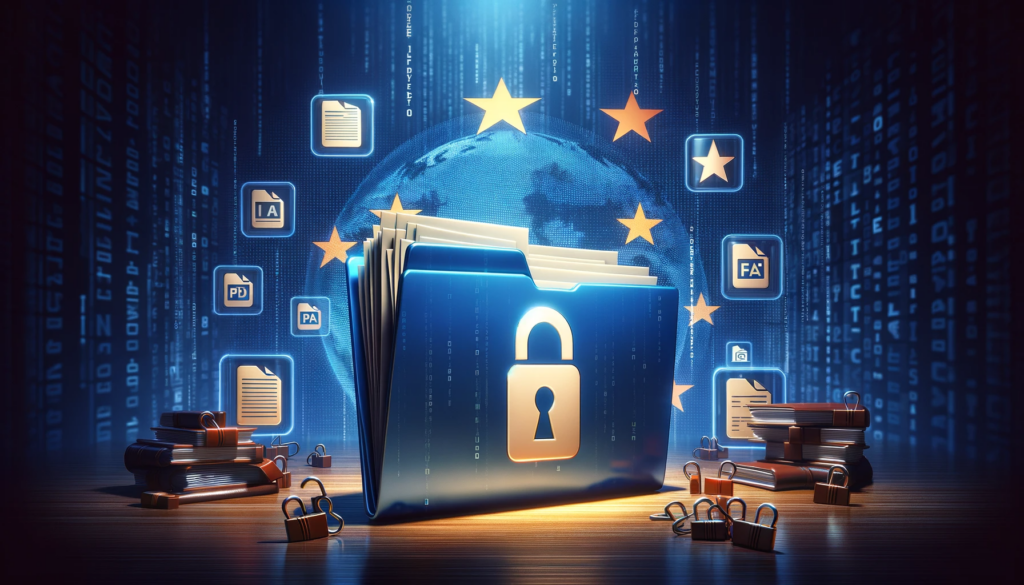Start using ezeep Blue for free now!
Just create a ezeep Blue account and you’re ready to start printing. ezeep Blue is free for up to ten users.

The ease of hitting ‘save to PDF’ might feel like second nature, especially when working with web apps. But in an era where data protection is paramount, this simple action can have far-reaching consequences. The EU’s General Data Protection Regulation (GDPR) has redefined privacy standards, particularly around GDPR-compliant data storage of personal data. In this post, we take a look at how local storage can be avoided, in particular for situations where it seems avoidable, such as when a user wants to print from a web-based app.
GDPR mandates specific measures for the storage of personal data. Two critical clauses to note are:
Storing PDFs locally, especially those containing sensitive information, opens a Pandora’s box of security risks. Data breaches can occur from stolen devices, malware, or even internal mishandling. Furthermore, operational inefficiencies arise, like the confusion of managing multiple document versions or the needless complexity of data retrieval—all of which are antithetical to the lean processes businesses strive for.
Several businesses have faced regulatory actions due to inadequate data storage practices. A real-world example is British Airways’ £20 million fine after a data breach that compromised customer data, partially due to local storage vulnerabilities.

Why does this matter for printing? Well, the act of printing often necessitates downloading a file locally. It’s common practice, yet paradoxically, it goes against the tide of secure information management. With the proliferation of no-code solutions and SaaS platforms, companies increasingly depend on web applications that require printers which are connected to web or backend systems. Connecting printers to these types of apps is often a challenge for organisations, however. Ensuring that a secure, private network connection between the printer and the cloud-based application is established without using cumbersome VPNs is not easy and is often more easily managed through a third-party print management solution.
What features then, does a print management solution need to wield to provide an answer to this use case?
Firstly, it must ensure GDPR data storage compliance by bypassing local storage in printing workflows. Such a solution should enable direct printing from the application, ensuring data remains in a secure environment throughout its lifecycle, respecting GDPR data storage time regulations by not creating unnecessary data at rest.
Additionally, robust user authentication processes, detailed audit trails, and end-to-end encryption are non-negotiables. And from an operational standpoint, ease of use and integration with existing systems are essential to ensure that business processes remain uninterrupted and efficient.
Enter ezeep, a solution crafted to meet the complexities of printing in a GDPR-conscious business environment. ezeep understands the precarious nature of GDPR data storage location requirements and has developed a cloud-based infrastructure that eliminates the need for local storage of documents before printing.
ezeep Blue’s API and ezeep.js – a JavaScript library – make it possible to integrate printing capabilities directly into any web application. This integration allows for a seamless “print now” button within the app interface, streamlining the printing process without the detour of creating and managing local PDF copies. This not only removes the inefficiency of traditional print processes but also significantly tightens data security, adhering to GDPR mandates against local storage of personally identifiable data.
The ezeep integration doesn’t end there; it extends to powerful automation platforms like Zapier and Make. These integrations facilitate the creation of automated print workflows from within the web apps that businesses already use, say for instance an Airtable-based app, without requiring extensive coding knowledge. This means immediate implementation of sophisticated print management processes that would traditionally take significant time and resources to establish.
Automating and tracking printing within key workflows is also no problem, yielding greater efficiency, reducing the need for support, and potentially increasing revenue. It’s not just about printing smarter; it’s about leveraging printing as an integrated part of your business operations to drive growth.
Moreover, ezeep also offers a small hardware appliance called the ezeep Hub which increases the ease of transition to cloud printing. This compact plug-and-play device connects to your network, automatically detects printers, and adds them to the cloud. When paired with an ezeep Hub, printers harness the unique driverless printing feature of ezeep Blue, freeing you from the constraints of installing drivers on print servers or endpoint devices. This innovation reflects a significant leap towards streamlined, serverless printing architectures that modern businesses require.
Lastly, ezeep’s commitment to sustainability is evident through its partnership with JustDiggit. This collaboration ensures that the CO2 footprint created by each print job processed by ezeep is offset, aiding companies in meeting their Corporate Social Responsibility (CSR) goals.
Saving PDFs locally might seem like a simple workaround for printing, but the potential GDPR ramifications can be severe. Adopt a proactive approach and prioritize the safety and security of personal data. Ensure that your print management solution is in line with GDPR requirements, and remember, the minor inconvenience of adjusting your print process is nothing compared to the potential penalties of non-compliance.
If this conversation sparks questions or if you’re contemplating the next steps in securing your print management, we encourage you to reach out. Connect with us and let’s ensure that your printing processes are as forward-thinking as your business deserves to be.
Just create a ezeep Blue account and you’re ready to start printing. ezeep Blue is free for up to ten users.